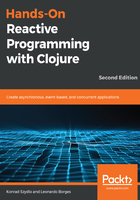
A bit of history
Before we talk about what Reactive Programming is, it is important to understand how other relevant programming paradigms influenced how we develop software. This will also help us understand the motivations behind Reactive Programming.
With a few exceptions, most of us will have been taught imperative programming languages such as C and Pascal or object-oriented languages such as Java and C++; either self-taught or at school/university
In both cases, the imperative programming paradigm of which object-oriented languages are a part dictates that we write programs as a series of statements that modify program state.
To understand what this means, let's look at a short program written in pseudocode that calculates the sum and the mean value of a list of numbers:
numbers := [1, 2, 3, 4, 5, 6] sum := 0 for each number in numbers sum := sum + number end mean := sum / count(numbers)
First, we create a new array of integers, called numbers, with numbers from 1 to 6, inclusive. Then, we initialize sum to 0. Next, we iterate over the array of integers, one at a time, adding the value of each number to sum.
Lastly, we calculate and assign the average of the numbers in the list to the mean local variable. This concludes the program logic.
This program would print 21 for the sum and 3 for the mean, if executed.
Though a simple example, it highlights its imperative style: we set up an application state, sum, and then explicitly tell the computer how to modify that state in order to calculate the result.